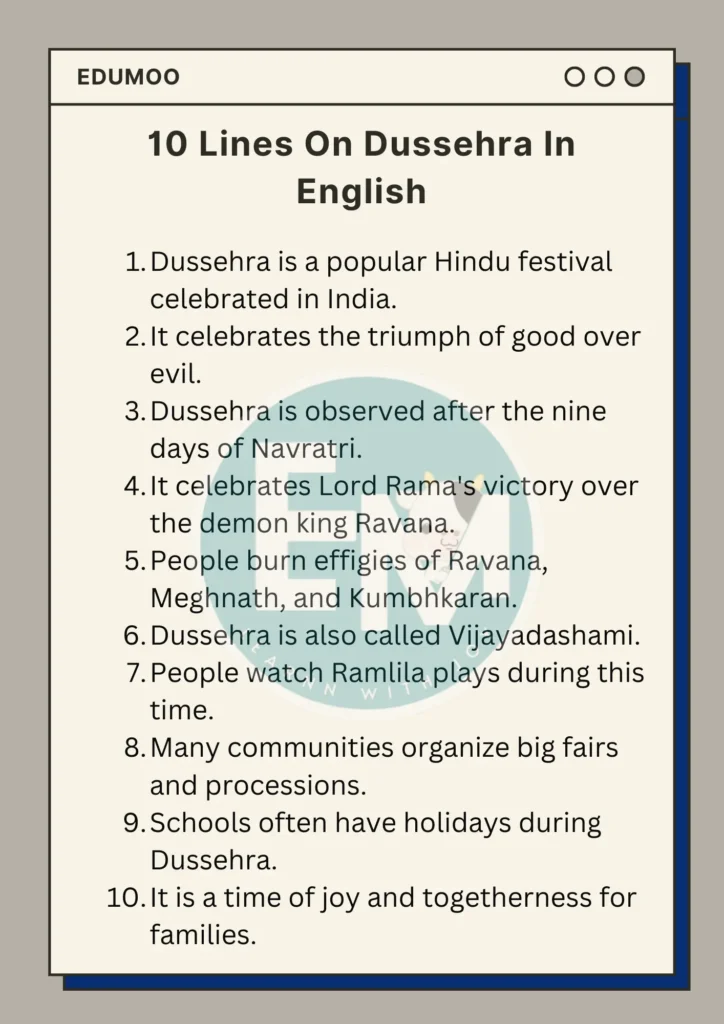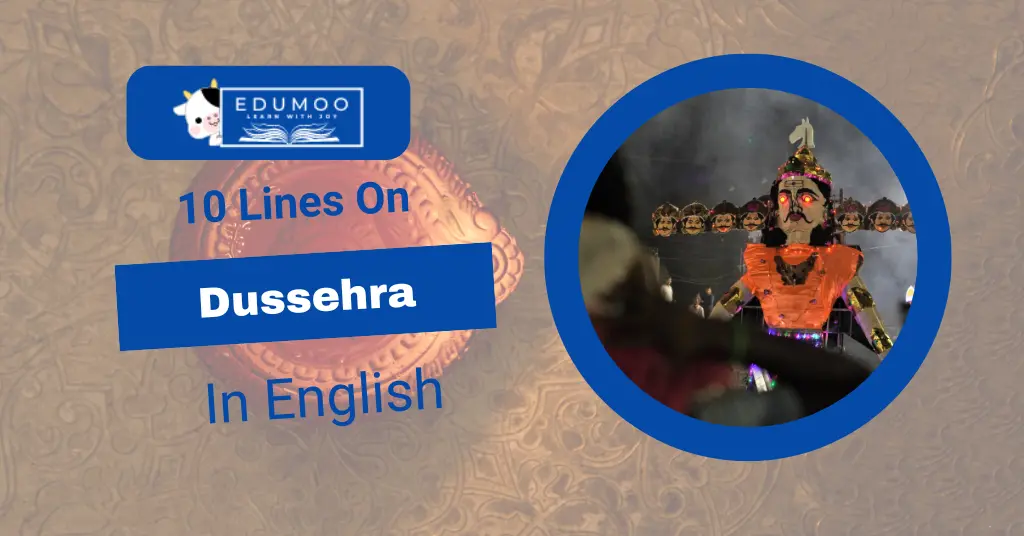Dussehra is one of the most important festivals in India, celebrated with great joy and enthusiasm. It marks the end of Navratri and symbolizes the victory of good over evil, as Lord Rama defeated the demon king Ravana. People eagerly wait for this day to watch Ramlila plays and see the effigies of Ravana being burned. Dussehra teaches us that truth and goodness always win in the end. Learn 10 lines on Dussehra for class students.
10 Lines On Dussehra In English
- Dussehra is a popular Hindu festival celebrated in India.
- It celebrates the triumph of good over evil.
- Dussehra is observed after the nine days of Navratri.
- It celebrates Lord Rama’s victory over the demon king Ravana.
- People burn effigies of Ravana, Meghnath, and Kumbhkaran.
- Dussehra is also called Vijayadashami.
- People watch Ramlila plays during this time.
- Many communities organize big fairs and processions.
- Schools often have holidays during Dussehra.
- It is a time of joy and togetherness for families.

Essay On Dussehra In English In 300 Words
Dussehra, also called Vijayadashami, is one of the most widely celebrated festivals in India. It falls in the month of September or October, marking the end of Navratri, a nine-day festival dedicated to the worship of Goddess Durga. Dussehra symbolizes the victory of good over evil, as it commemorates the day when Lord Rama defeated the demon king Ravana.
The story of Dussehra is derived from the ancient Hindu epic, Ramayana. According to the legend, Ravana, the king of Lanka, kidnapped Lord Rama’s wife, Sita. To rescue her, Lord Rama fought a fierce battle with Ravana, which lasted for ten days. On the tenth day, Lord Rama defeated Ravana, symbolizing the triumph of truth and virtue over evil and sin. This day is celebrated as Dussehra.
On Dussehra, people in different parts of India celebrate with great enthusiasm. Large effigies of Ravana, along with his brother Meghnath and son Kumbhkaran, are made and then set on fire. This act represents the destruction of evil. Before the effigies are burned, Ramlila plays are performed, depicting scenes from the Ramayana, especially the battle between Lord Rama and Ravana.
Dussehra is a time of joy and excitement, especially for children. Many places hold fairs, where people enjoy rides, games, and delicious food. The festival is also a reminder of the importance of standing up for what is right and just. Dussehra teaches us that no matter how powerful evil might seem, it will always be defeated by truth and goodness.
In conclusion, Dussehra is a festival that fills our hearts with hope and happiness. It reminds us of the victory of good over evil and encourages us to lead a life of truth and righteousness. Celebrating Dussehra brings people together and strengthens the bond of community and family.
| Also Read: 10 Lines On Gandhi Jayanti |
Essay On Dussehra In English In 900 Words
Dussehra, also known as Vijayadashami, is one of the most important and widely celebrated festivals in India. It holds deep cultural and religious significance and is observed with great enthusiasm and devotion across the country. Dussehra marks the victory of good over evil, symbolizing the triumph of righteousness and truth. This festival falls on the tenth day of the bright half (Shukla Paksha) of the Hindu month of Ashwin, which usually corresponds to September or October in the Gregorian calendar. The festival comes after the nine days of Navratri, during which devotees worship the nine forms of Goddess Durga.
The celebration of Dussehra is rooted in ancient Hindu mythology. The most famous story associated with Dussehra is the tale of Lord Rama, an incarnation of Lord Vishnu, and his victory over the demon king Ravana. According to the epic Ramayana, Ravana, the ten-headed king of Lanka, abducted Sita, the wife of Lord Rama.
In his quest to rescue Sita, Lord Rama, along with his brother Lakshmana and the devoted monkey god Hanuman, waged a battle against Ravana. The war lasted for ten days, culminating in the defeat and death of Ravana on the tenth day, which is celebrated as Dussehra. This story symbolizes the victory of good (Lord Rama) over evil (Ravana) and serves as a reminder that truth and righteousness always prevail in the end.
Another significant legend associated with Dussehra is the victory of Goddess Durga over the buffalo demon Mahishasura. Mahishasura was a powerful demon who terrorized the gods and people alike. To end his tyranny, the gods created Goddess Durga, who fought Mahishasura for nine days and finally defeated him on the tenth day, which is celebrated as Vijayadashami. This legend emphasizes the power of divine feminine energy and the importance of standing against evil forces.
Dussehra is celebrated with diverse customs and traditions in different parts of India, reflecting the cultural richness of the country. In North India, especially in states like Uttar Pradesh, Bihar, and Delhi, Dussehra is marked by the staging of Ramlila, a dramatic reenactment of the life of Lord Rama, culminating in the burning of huge effigies of Ravana, his brother Meghnath, and son Kumbhkaran.
The effigies are filled with firecrackers, and their burning signifies the destruction of evil. These events are attended by large crowds who come together to witness the victory of good over evil.
In West Bengal, Dussehra coincides with the last day of Durga Puja, a festival dedicated to the worship of Goddess Durga. On this day, idols of Goddess Durga are immersed in rivers or other water bodies with great devotion and fanfare. The immersion, known as “Visarjan,” is accompanied by joyous processions, music, and dancing. People bid farewell to the goddess with the hope that she will return the next year to bless them.
In the state of Karnataka, especially in the city of Mysore, Dussehra is celebrated as a royal festival. The Mysore Palace is beautifully illuminated, and a grand procession featuring decorated elephants, horses, and soldiers is held. The festival has been celebrated in Mysore for centuries and attracts tourists from all over the world.
In Gujarat, Dussehra is celebrated with the traditional dance form called Garba, which continues throughout the Navratri festival
Dussehra is not just a festival but a reminder of the timeless values that are central to Hindu philosophy. The stories associated with Dussehra emphasize the importance of righteousness, truth, and the victory of good over evil. Lord Rama’s victory over Ravana teaches us that no matter how powerful evil might seem, it will eventually be defeated by goodness and justice. Similarly, Goddess Durga’s triumph over Mahishasura highlights the strength and power of the divine feminine and the need to stand against oppression and injustice.
Dussehra also signifies the end of the harvest season in many parts of India. It is a time when farmers express gratitude to the gods for a bountiful harvest and pray for prosperity in the coming year. The festival thus has both religious and cultural significance, bringing people together in a spirit of unity and celebration.
Dussehra is a festival that is deeply ingrained in the cultural and spiritual fabric of India. It is a time of joy, celebration, and reflection. The burning of Ravana’s effigy is not just a symbolic act but a reminder to eliminate the negative qualities within us, such as anger, greed, and jealousy. The festival encourages us to embrace the virtues of truth, righteousness, and goodness in our lives.
Dussehra also brings people together, fostering a sense of community and togetherness. Families come together to celebrate, exchange gifts, and share festive meals. The festival is a time to strengthen bonds, both within families and within society. As we celebrate Dussehra, we are reminded of the eternal truth that good will always triumph over evil, and light will always conquer darkness.
In conclusion, Dussehra is more than just a festival; it is a celebration of the values that guide us in our daily lives. It inspires us to be better individuals and to strive for a just and righteous life. The festival fills our hearts with hope and joy, making it a truly special occasion for everyone.
Conclusion
Today, we have learnt 10 lines on Dussehra. Dussehra is not just a festival but a reminder of the power of goodness and truth. It brings people together to celebrate and share happiness. As we watch the effigies burn, we are reminded to always stand for what is right and just. Dussehra fills our hearts with hope and joy, making it a special time for everyone.

